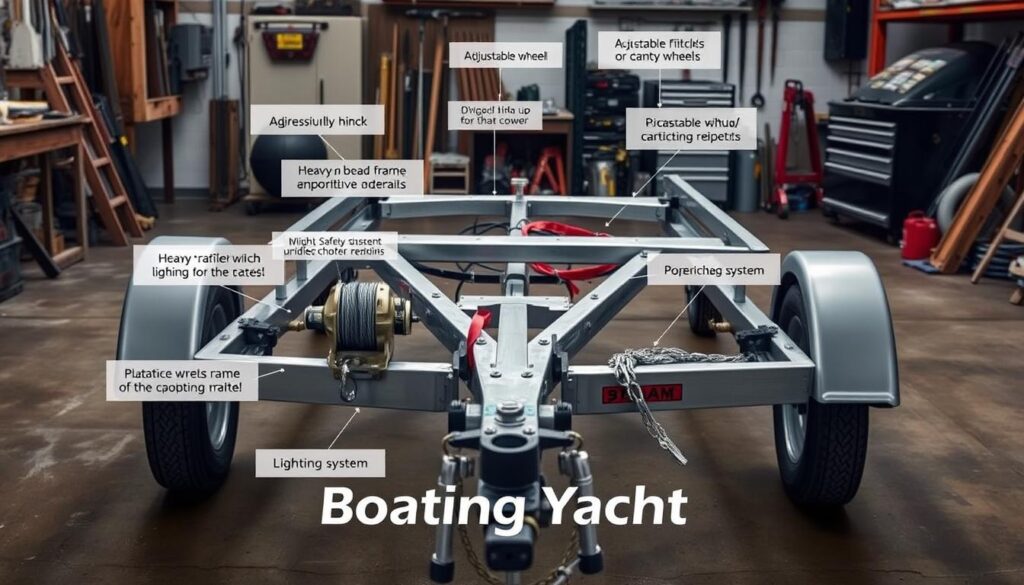Boat trailer parts are the unsung heroes of any boating journey. When was the last time you checked yours? It’s time to give them a little attention, if it is for a while. Skipping maintenance can turn an exciting day on the water into a frustrating ordeal before you even leave the driveway. As Captain John Spencer, a seasoned marine expert, regularly says, ‘Your boat’s protection begins lengthy earlier than it hits the water—it is all within the trailer.’
Each element plays an important function, from the trailer lights that signal your movements on the road to the brakes that ensure clean stops. The axles and tires convey the weight of your boat, while the winch and ramps make launching and retrieving your vessel a breeze. Even skilled boaters like Sarah McCallum, a yacht proprietor, insist on doing quick exams before every journey. ‘I always check out my tires and brakes. It takes 5 minutes but can keep me from hours of trouble,’ she says.
To preserve your boat trailer components in pinnacle shape:
Regularly inspect winches, ramps, and hardware for put-on—staying proactive is fundamental to a smooth, safe experience.
Do short inspections before every journey and a total yearly test.
Look out for rust on the frame, check tire stress, and ensure lighting fixtures and brakes are working.
Table of Contents
Regular Maintenance
Essential for safe and successful boating.
Essential Components
Include trailer lights, brakes, tires, axles, hitches, and accessories.
Pre-Trip Checks
Quick checks before every outing, annual thorough inspection.
Lights & Brakes
Ensure lights and brakes are functioning for road safety.
Inspect for Damage
Check trailer frame, wheels, tires, and accessories for wear and damage.
Trailer Frame and Structural Components
The trailer body is the heart of your boat trailer. It provides the support and stability your boat trailer needs during shipping. When choosing a boat trailer body, look for something strong and resistant to rust. This guarantees it will last a long time.
Choosing a Sturdy and Rust-Resistant Frame
Aluminum frames are a top preference for boat trailers. They are lightweight and don’t rust or corrode effortlessly, making them high-quality for towing and keeping the trailer light.
When picking an aluminum frame, remember your boat’s length and weight. This guarantees the body can deal with it well.
Other parts are also essential for the trailer’s strength. Cross participants, made from L-angle or C-channel, spread out the weight. The tongue beam, made from the square tube or C-channel, links the trailer to the tow car and contains a lot of weight.
Axles: Single, Double, or Triple Options
Torsion axles are key to your boat trailer. They manage the trailer and boat’s weight. Depending on your boat’s length and weight, you may need single, double, or triple axles.
Each kind has its benefits. They affect how the trailer handles, its balance, and how smooth it is to transport.
| Axle Configuration | Typical Axle Sizes | Weight Capacity |
|---|---|---|
| Single Axle | 3,500 lb. | Up to 3,500 lbs. |
| Double Axle | 3,500 lb. – 7,000 lb. | Up to 14,000 lbs. |
| Triple Axle | 6,000 lb. – 8,000 lb. | Up to 24,000 lbs. |
Choosing the right axles depends on your boat’s weight, length, and in which you will use it. Talking to a trailer professional can help you pick a satisfactory option.
By selecting a strong, rust-resistant frame and the right axles, your boat trailer will last a long time. Always inspect and maintain these elements to keep your trailer secure and in good shape.
Wheels, Tires, and Braking Systems
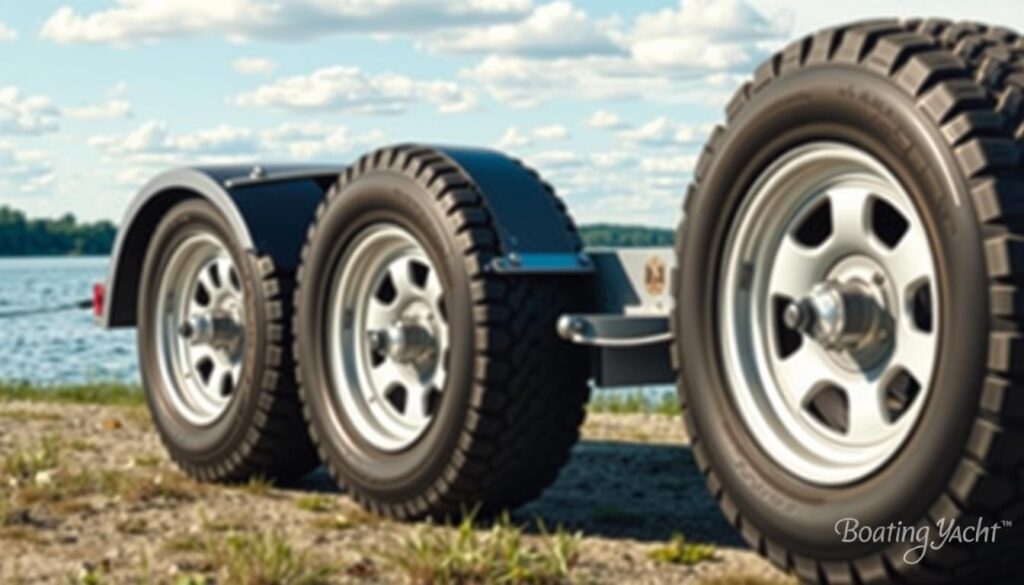
Proper wheels, tires, and brakes are essential for safe and easy towing. Choose the right boat trailer wheels and tires for your trailer’s size and towing distance. This preference significantly impacts your boating revel in.
Selecting Appropriate Wheels and Tires
Ensure your boat trailer tires can handle your boat’s weight and pace. Always check tire strain earlier than you cross. Underinflated tires put on down faster, use extra gas, and might even blow out.
Consider durable CE Smith, CT Johnson, Fulton, and Martin Wheel tires. They offer several tires and rims that fit your needs.
Maintaining and Inspecting Trailer Brakes
Most trailers have brakes to assist in slowing down and prevent sluggishness. These brakes need ordinary exams to be painted right. Look at your trailer brakes before each journey.
Check brake pads, rotors, and drums for wear. Adjust or update components as needed to keep brakes working well.
| Component | Inspection Frequency | Maintenance Tasks |
|---|---|---|
| Tires | Before each trip | Check tire pressure, inspect for wear and damage. |
| Wheels | Monthly | Check for cracks, dents, or corrosion; ensure lug nuts are tight. |
| Brake Pads | Every 3,000 miles or annually | Inspect for wear, replace if necessary. |
| Brake Rotors/Drums | Every 6,000 miles or annually | Inspect for wear, damage, or warping; replace if needed. |
By picking the right wheels and tires, keeping tires inflated, and checking brakes, you’ll have a safe and fun boating time. Follow these steps for years of enjoyment on the water.
Boat Trailer Parts for Secure Loading and Unloading
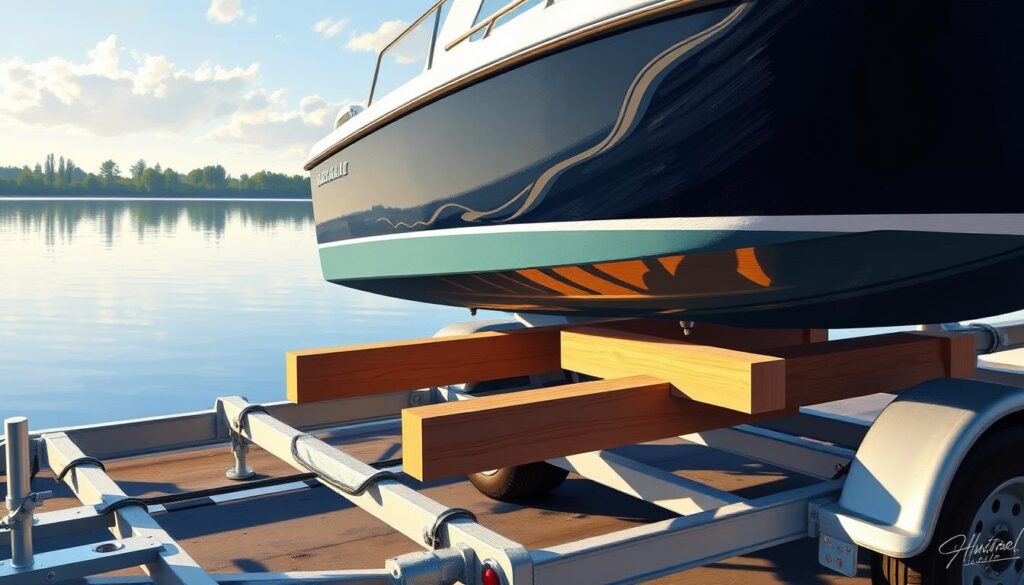
Boat trailer components like bunks, rollers, winches, and bow stops are crucial for secure loading and unloading. They work together to assist the hull and maintain it stable, making launching and retrieving your boat easier and safer.
Bunks and Rollers for Easy Launch and Retrieval
Boat trailer bunks and rollers help the boat’s hull, spreading its weight lightly. This reduces harm risk during loading and unloading. Bunks, made from carpeted wood or composite, offer a soft floor in your boat.
On the other hand, rollers are characteristic rubber or polyurethane rollers for smooth gliding. They’re excellent for large or complicated boats, lowering friction. Choose bunks or rollers based on your boat’s length, weight, and form for first-rate support.
Winch and Bow Stop Positioning and Maintenance
The winch and bow forestall hold your boat steady at the trailer. The winch pulls the boat on and holds it. A properly maintained winch is crucial for secure use. Regularly check it for wear and update it if needed.
The bow prevents the boat from sliding by positioning it correctly. Adjust it to your boat’s size and shape. Check it often to ensure it is securely attached.
| Brand | Bunk Material | Features |
|---|---|---|
| Tie Down Engineering | Carpeted wood | Quick-Slide support bunk covers |
| Fulton | Polyethylene | Adjustable mounting brackets |
| C.E. Smith | PVC-wrapped wood | UV-resistant and easy to clean |
Investing in quality boat trailer parts ensures safe transport. Regular maintenance extends their life and keeps your boat in great shape. For more on boat trailer parts, visit Trailers and Transport’s guide.
Electrical Components: Lights and Wiring
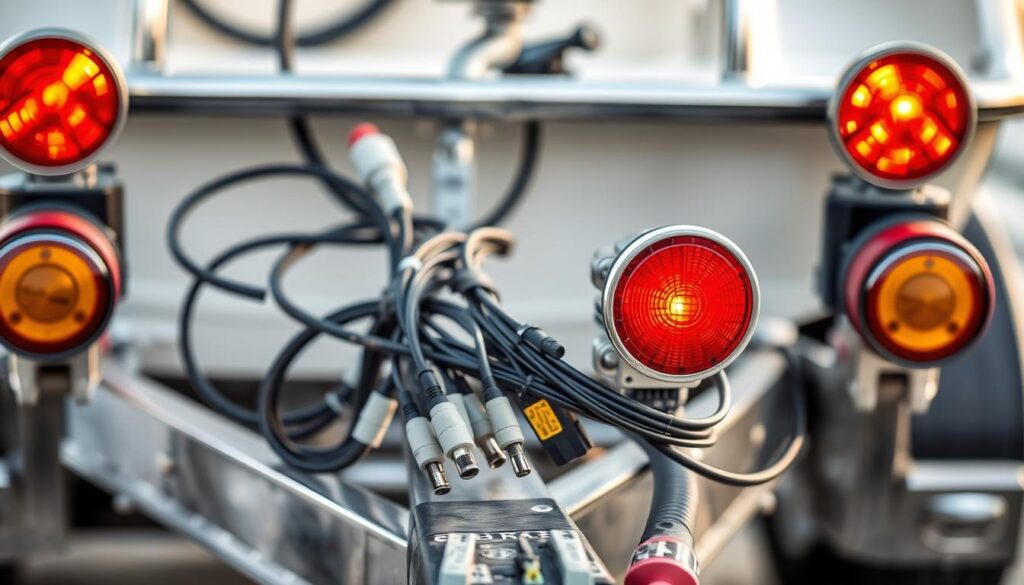
Boat trailer parts include essential electrical components for safe towing. Boat trailer lights are key for road visibility and following the law. A trailer wiring harness connects your vehicle’s electrical system to the trailer, making sure all lights work together.
The wiring harness powers the trailer’s lights, like taillights and turn signals. It makes your trailer visible to others, especially in bad weather or at night. It also supports trailer brakes and can power accessories like winches or extra lights.
4-Way Flat Connectors
5-Way Flat Connectors
6-Way Round Connectors
7-Way Round Connectors
The number of pins on the connector shows how many functions it supports. For example, a 4-way connector handles basic lights. A 7-way connector supports more, like trailer brakes and reverse lights.
“Investing in a high-quality trailer wiring harness and properly maintaining your boat trailer lights can save you from costly repairs and ensure a safe towing experience.” – Michael Johnson, Boating Enthusiast
Here are some tips for installing or maintaining your boat trailer lights and wiring harness:
| Component | Maintenance Tips |
|---|---|
| Taillights | Check for cracks, moisture, or corrosion in the light housings. Make sure the lenses are clean and free from debris. |
| Wiring Harness | Look for wear, fraying, or exposed wires. Apply dielectric grease to the connector pins to prevent corrosion. |
| Ground Connection | Make sure the ground connection is secure and free from rust or corrosion. A bad ground connection can cause light failures. |
By keeping your boat trailer lights and wiring harness in good shape, you ensure they work well. Regularly check and replace damaged parts to keep your trailer safe and reliable.
Safety Features and Accessories
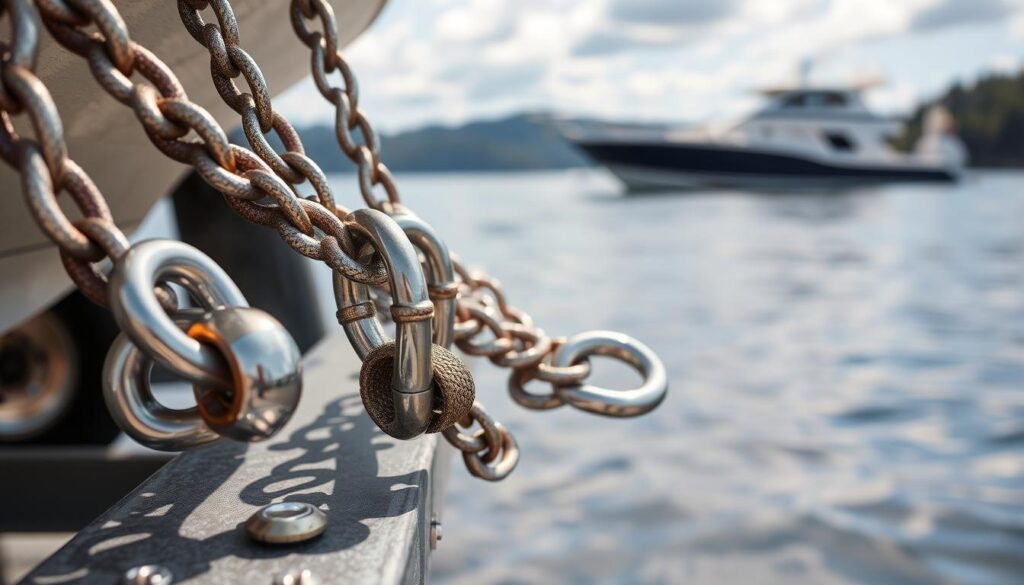
Boat trailer protection is key to an easy towing experience. About 65% of trailer injuries are caused by safety characteristic defects. So, it’s critical to invest in first-rate safety parts and keep them updated.
The Importance of Safety Chains and Straps
Safety chains and straps are vital as a backup. They keep the boat attached in case of trouble. Studies show that trailers with suitable protection components have a 25% decrease in accident fees. Make certain your chains and straps are in appropriate shape and securely attached.
Properly Sizing and Maintaining the Coupler
The coupler connects the trailer to the hitch. It’s crucial to pick out the proper length for your setup. Regular exams and maintenance are also key to avoiding dangers on the road. For more guidelines, go to BoatingYacht.Com.
Fenders for Protection from Debris and Road Spray
Fenders guard your boat and tires from street debris and spray. They reduce damage hazards and make towing safer. Choose fenders based on size, cloth, and durability for first-class protection.
Regular protection checks can cut coincidence hazards via forty. Keeping up with preservation is essential. Here’s an easy renovation timetable:
| Maintenance Task | Frequency |
|---|---|
| Inspect safety chains and straps | Before each trip |
| Check coupler for wear and proper fit | Monthly |
| Inspect and clean trailer fenders | Every 3 months |
| Lubricate coupler and hitch components | Every 6 months |
Focus on your boat trailer’s safety features to prevent accidents. Always seek professional recommendations and test out BoatingYacht.Com for the latest protection tips.
Buying a top-notch boat trailer is fundamental for secure and smooth boat delivery. Consider your boat’s size and weight when choosing a trailer. Expert recommendations can help you choose the quality trailer you desire.
Keeping your trailer in good shape is also essential. Ordinary assessments can prevent issues like worn tires, damaged brakes, and rust. By performing visible inspections and keeping an eye on tire pressure, you may prolong the life of your trailer.
Knowing how every part of your trailer works is essential. This includes the body, axles, brakes, and wheels. Taking care of your trailer will ensure it lasts longer and keep you safe on the water. A nicely kept trailer is critical for first-rate boating journeys, giving you confidence and peace of mind.

